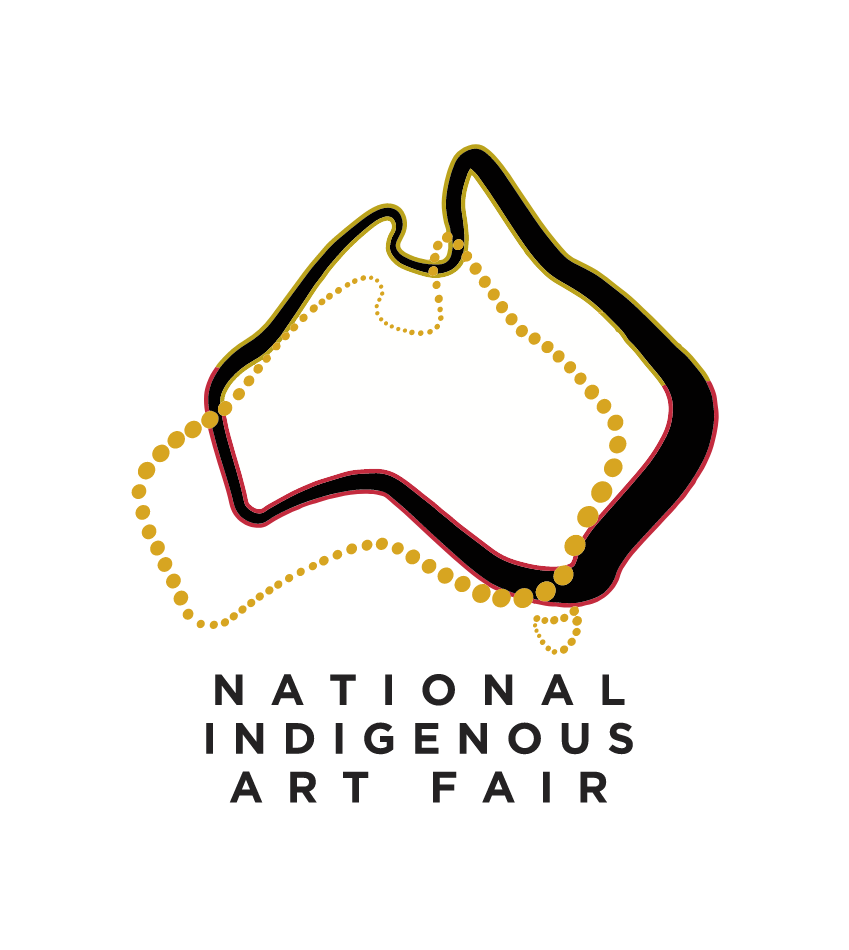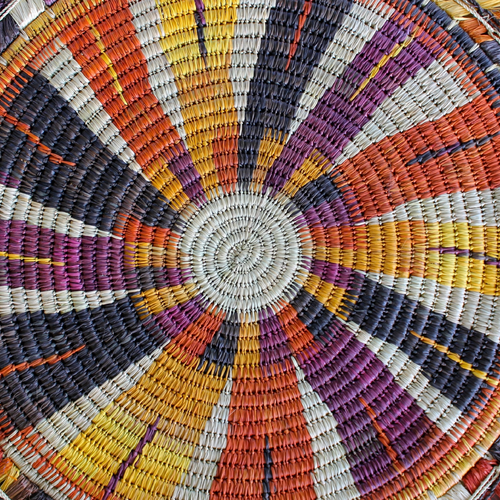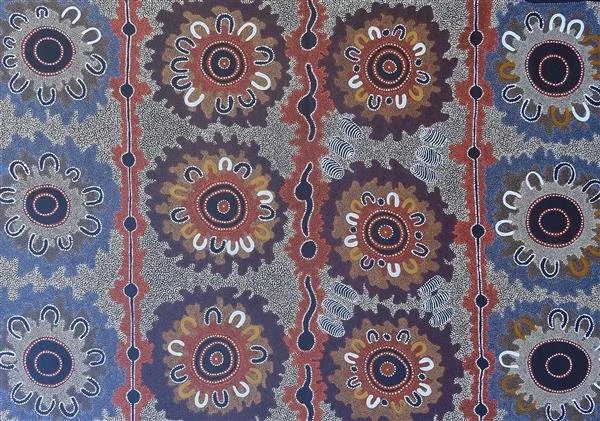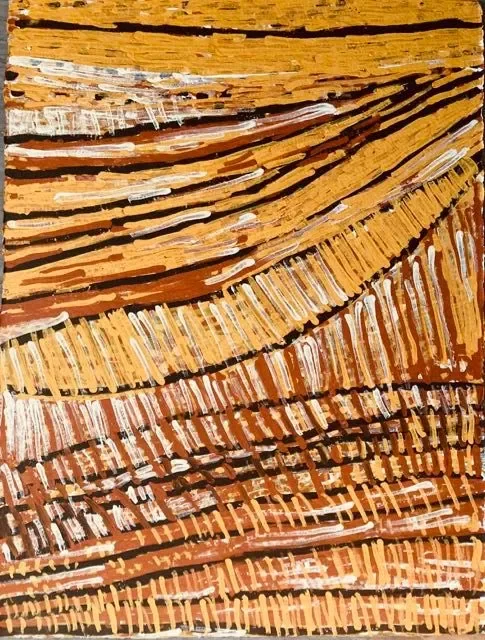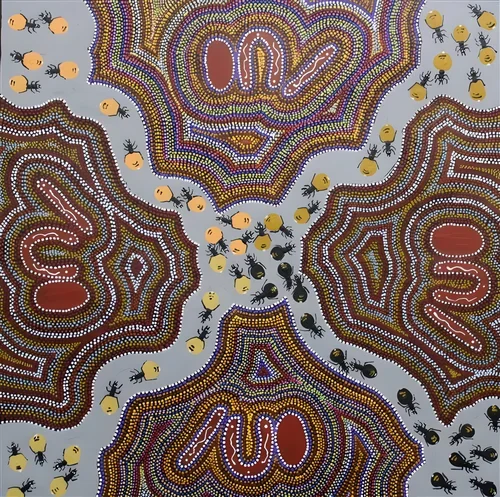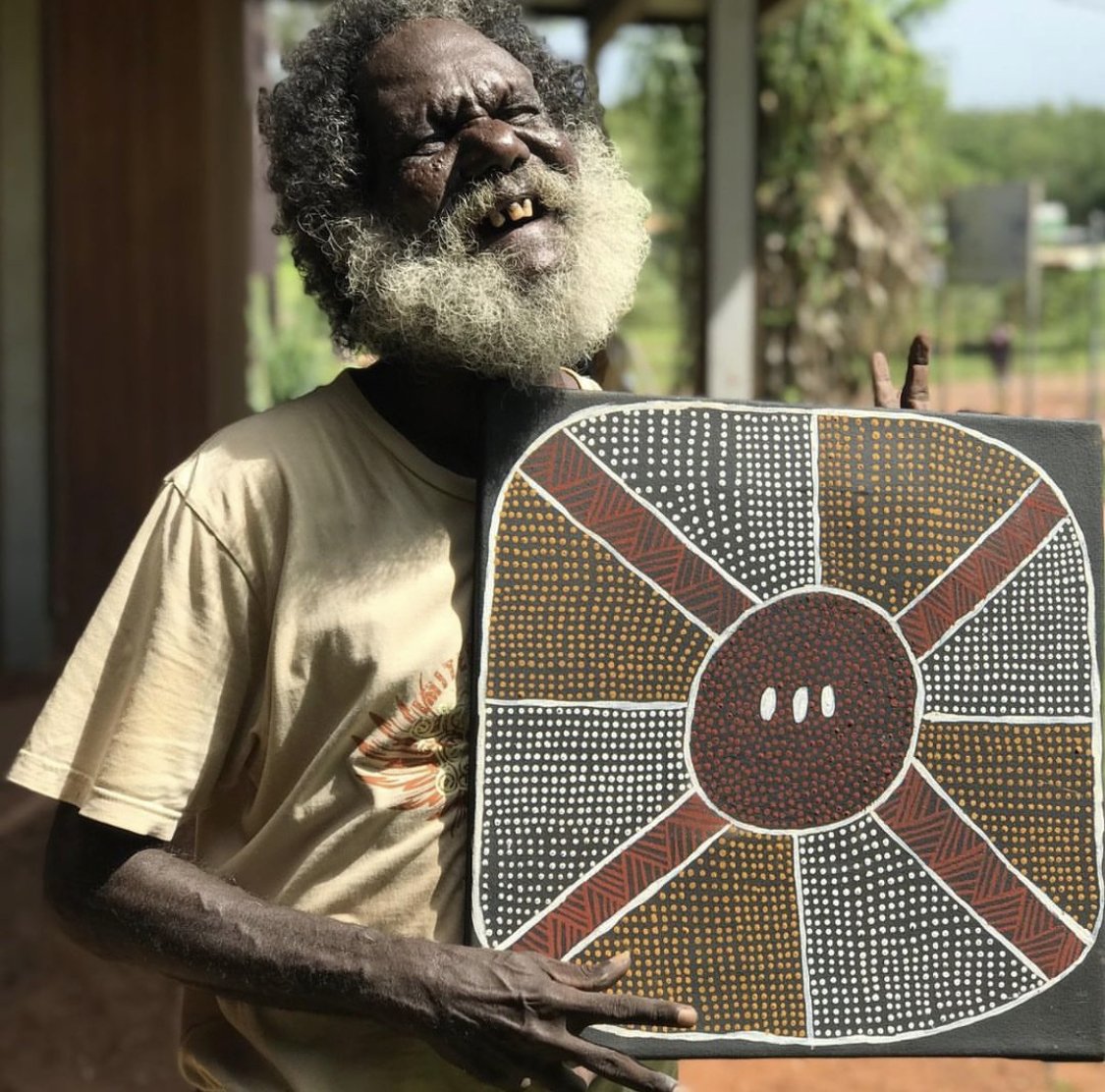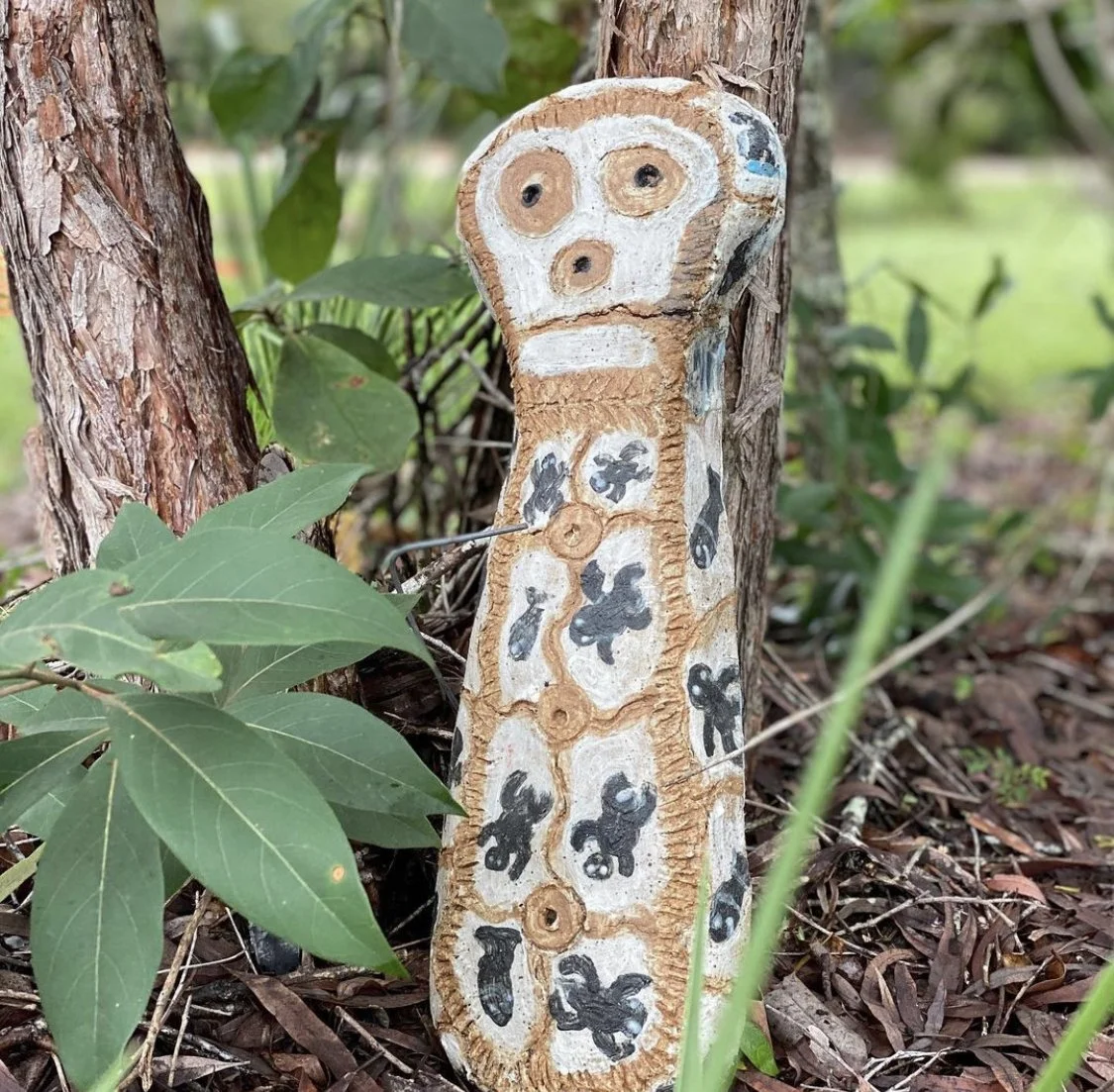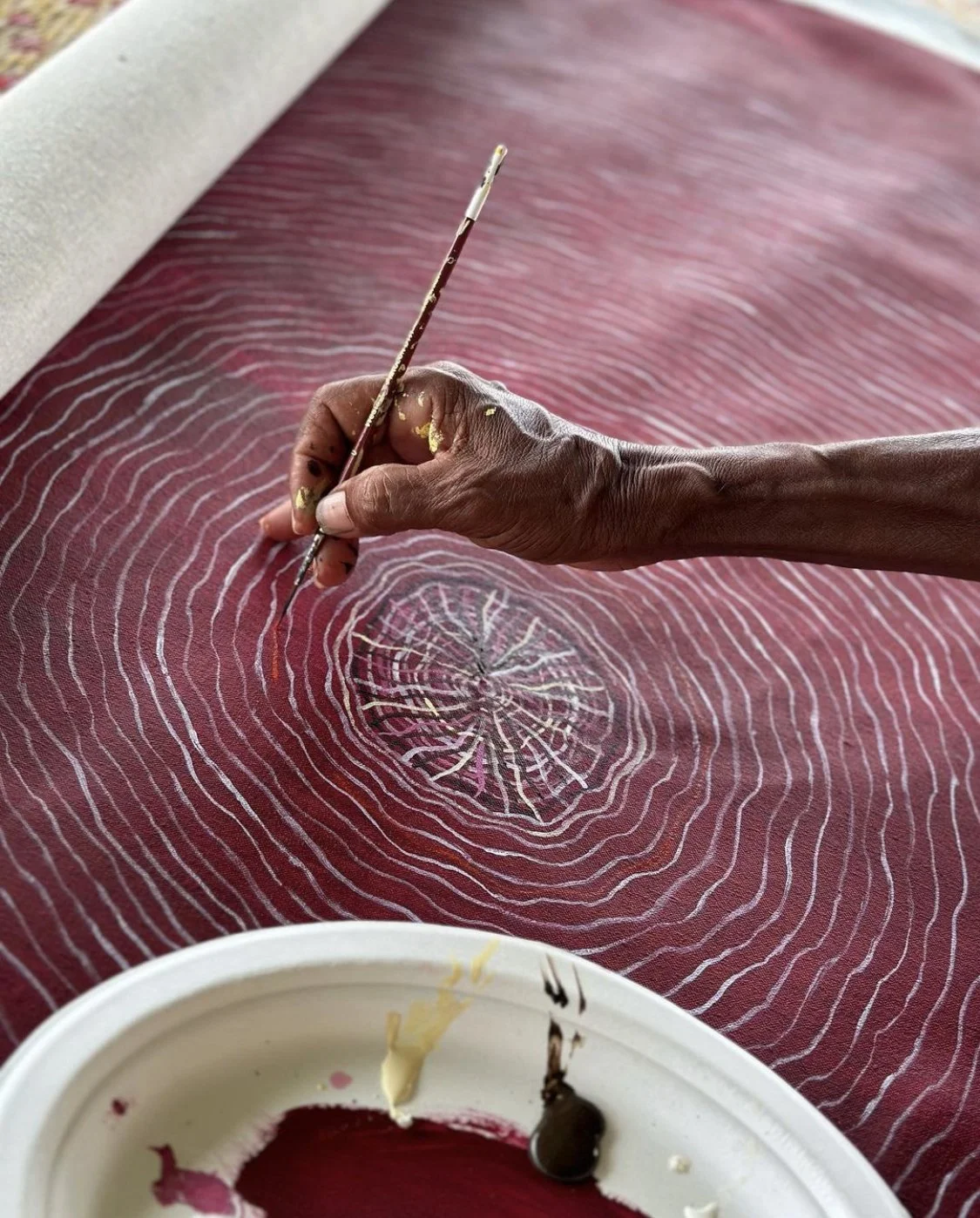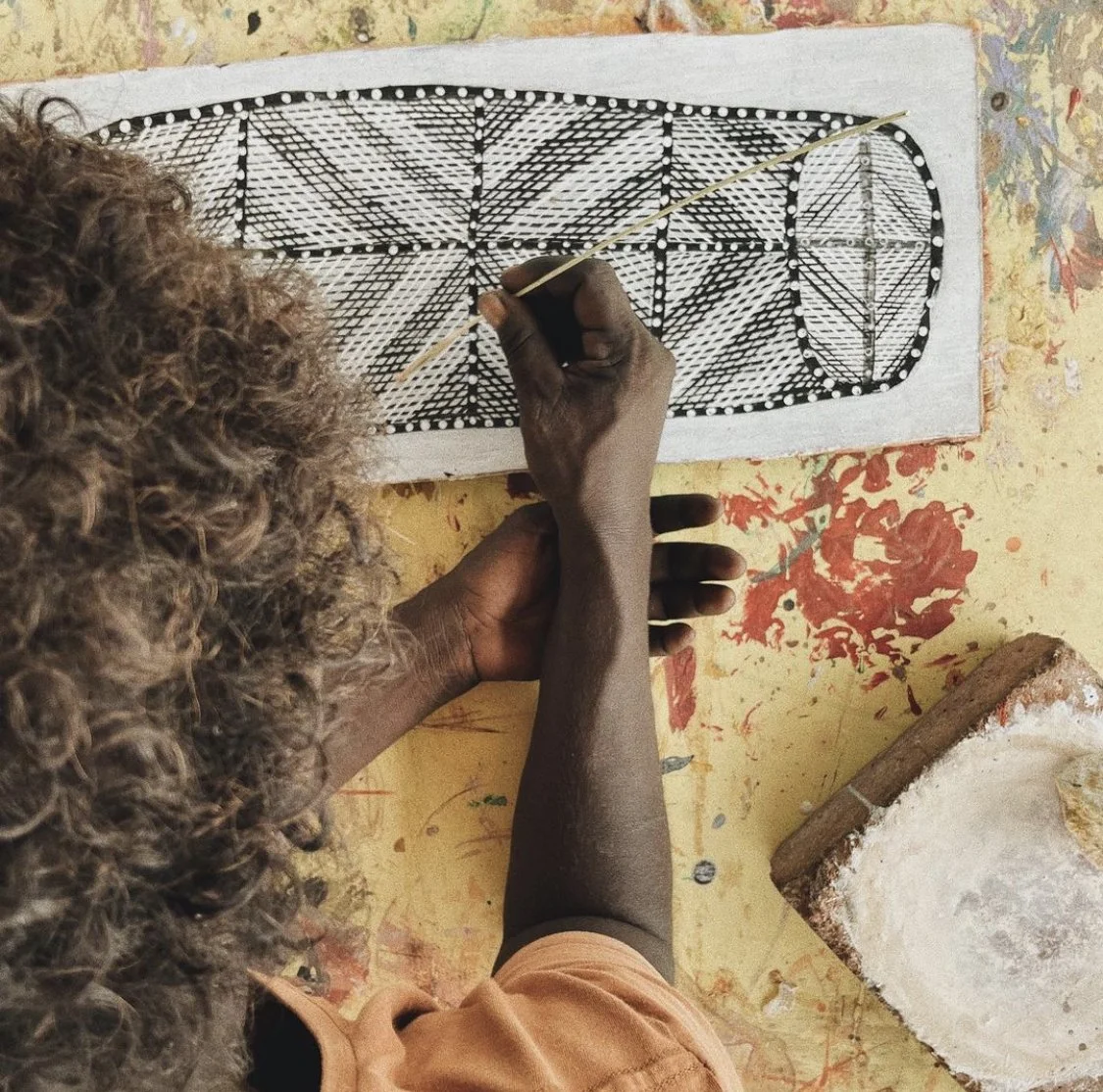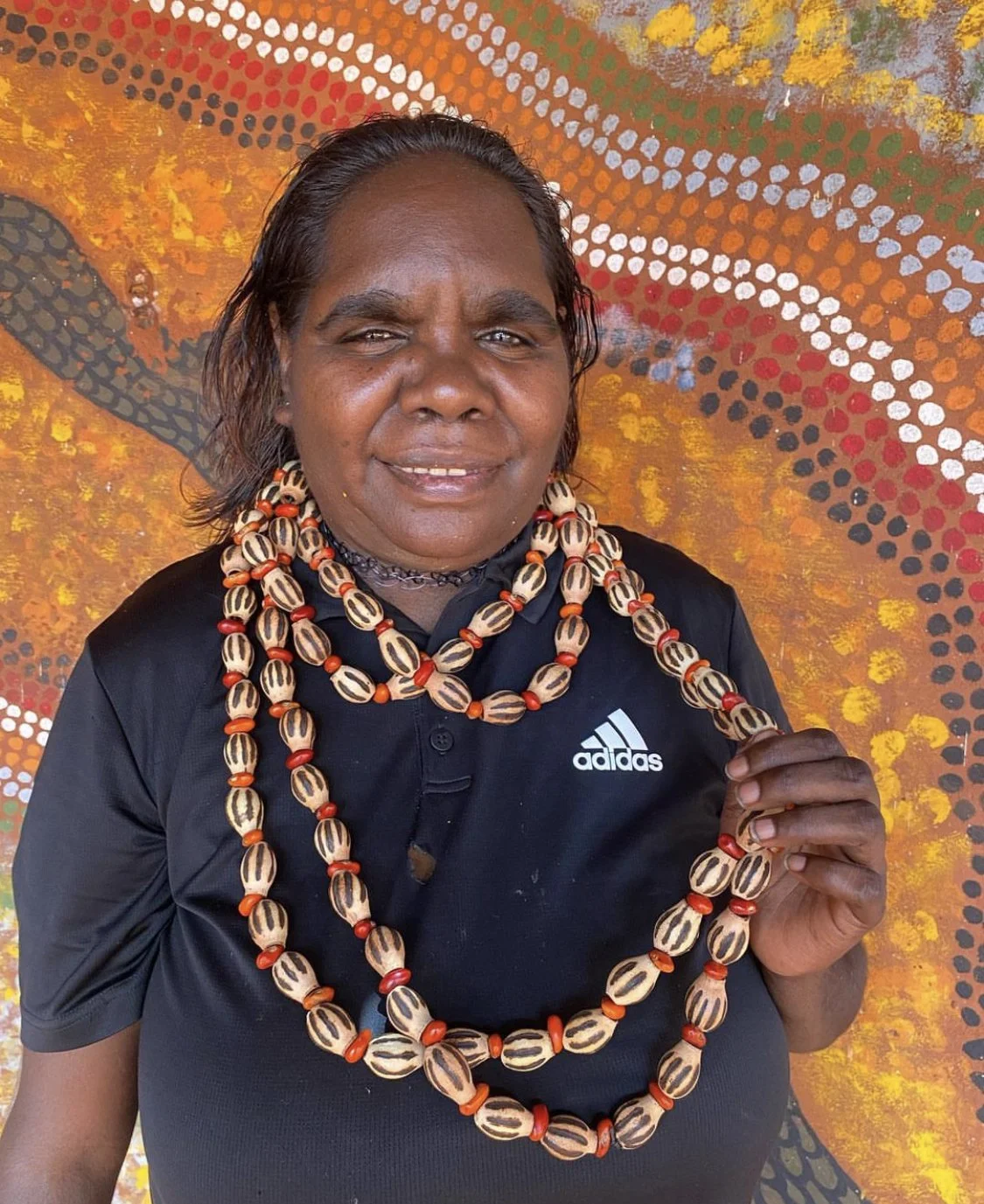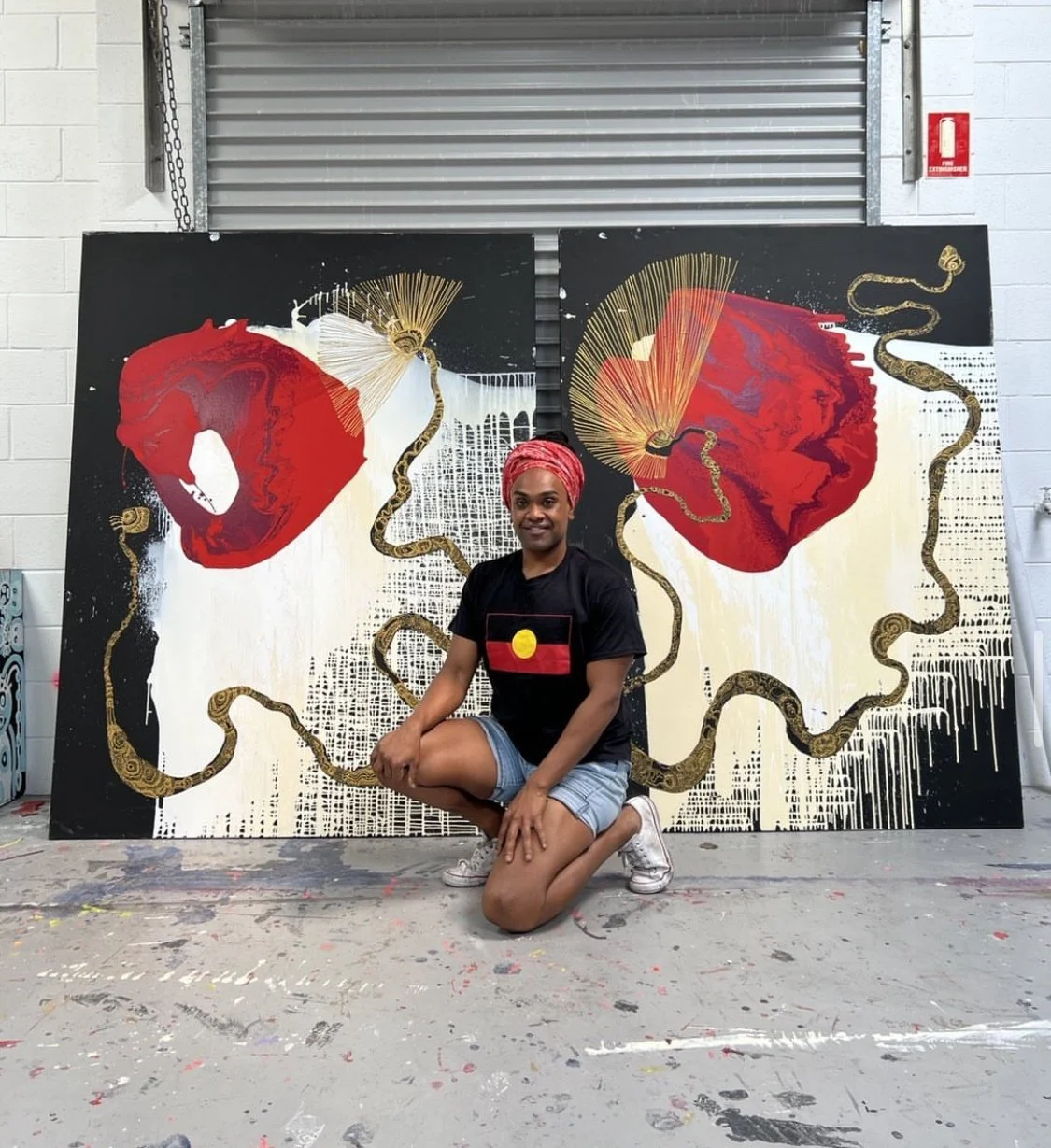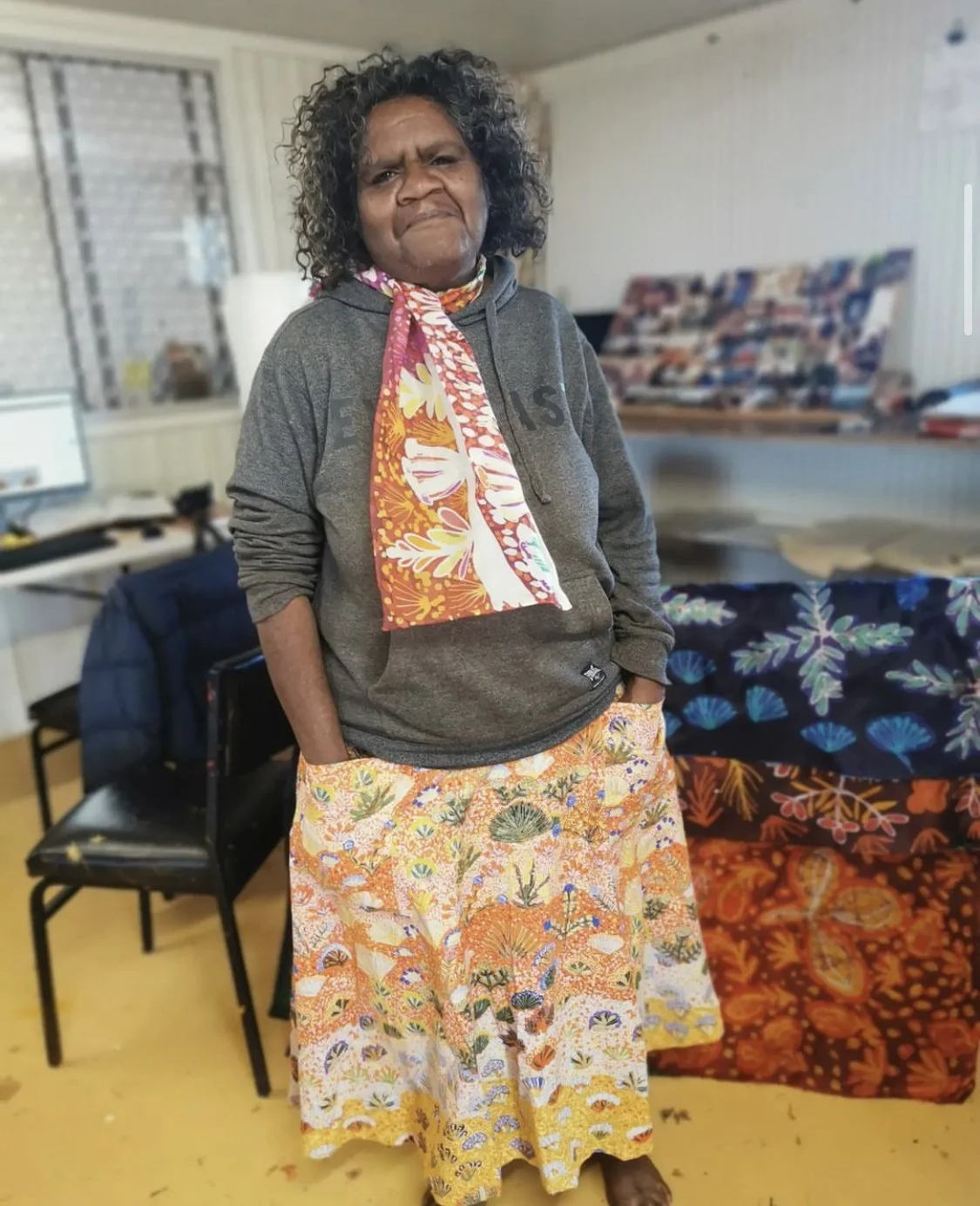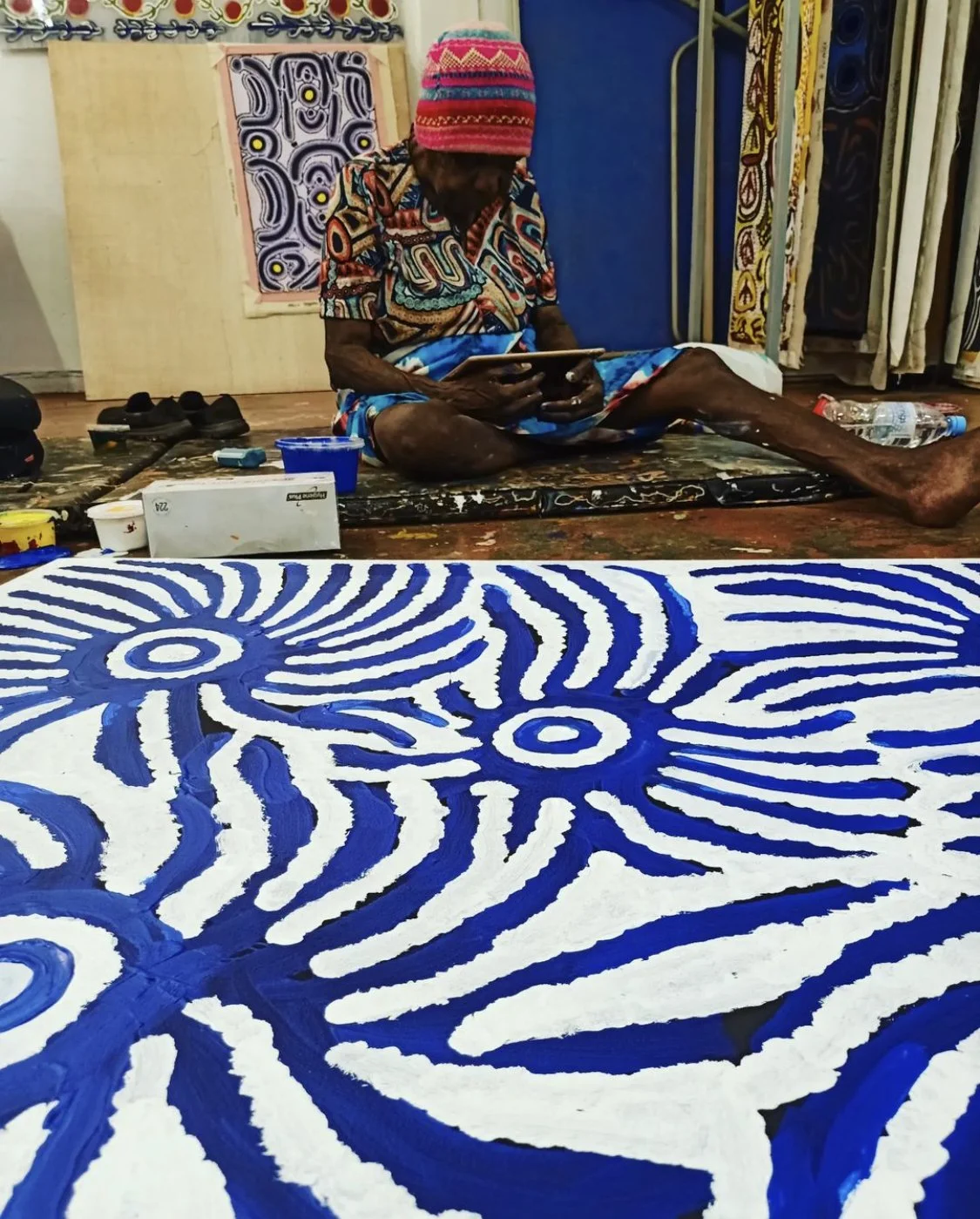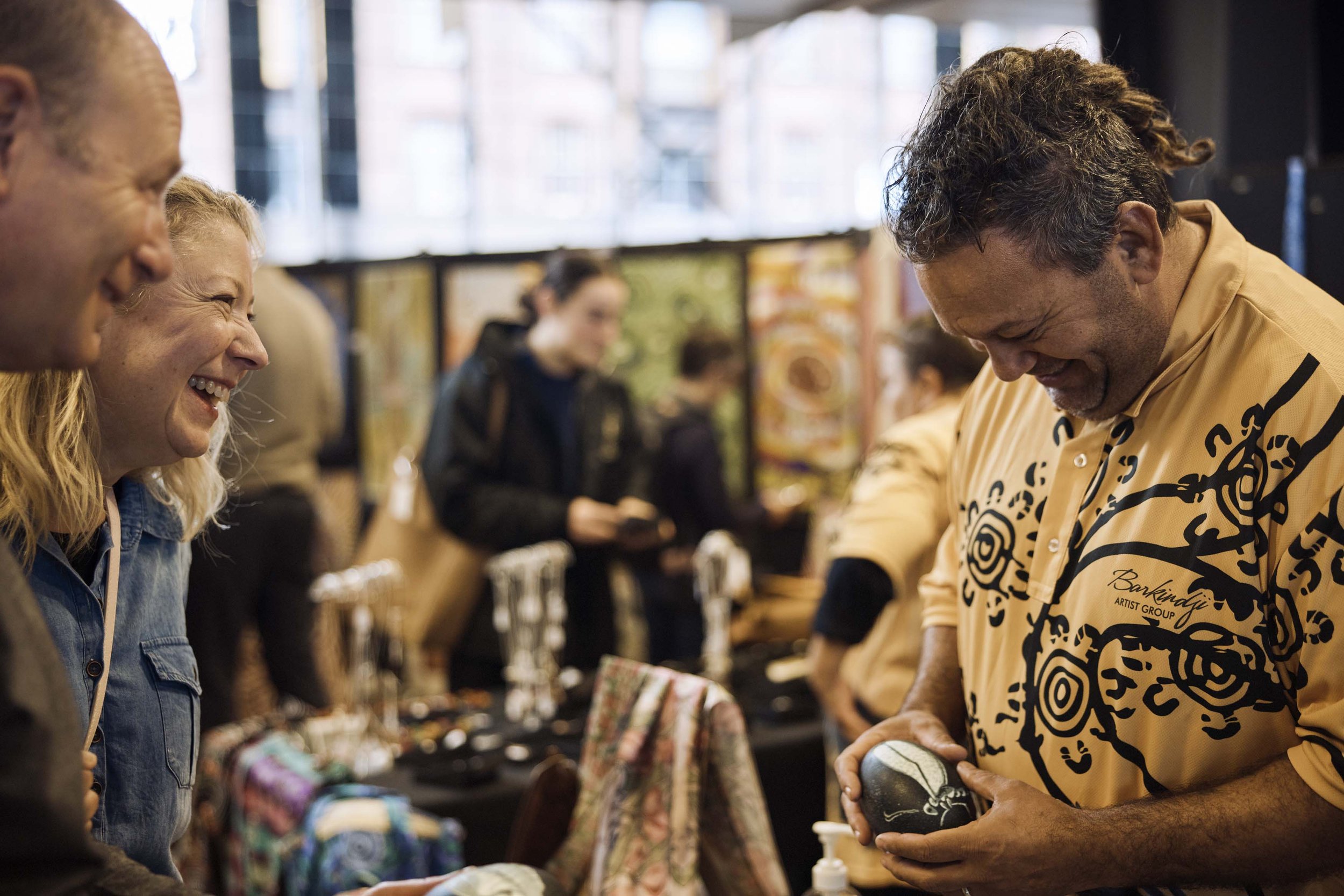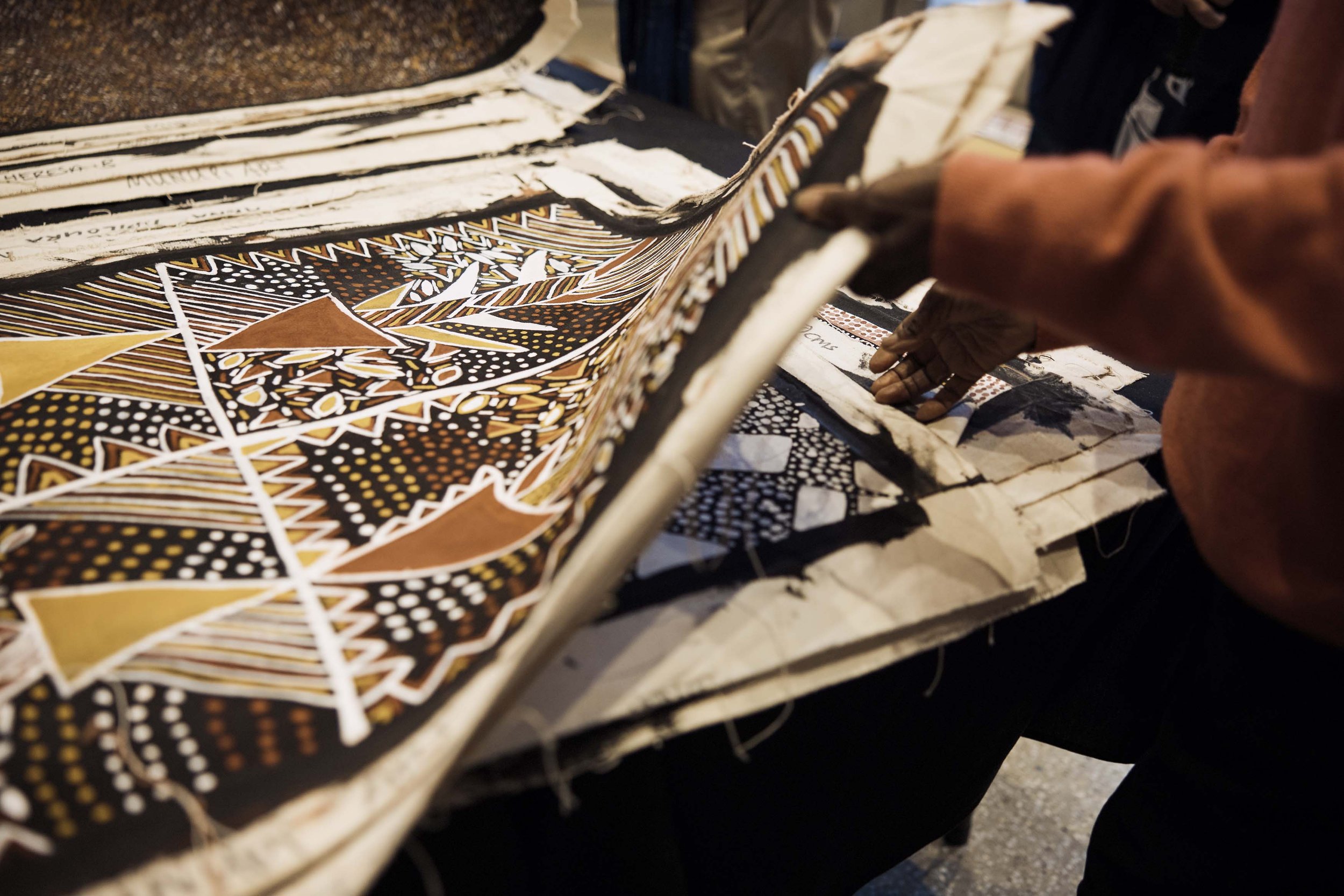
Art centres attending NIAF 2025
We started our Art Fair to support remote art centres to:
Develop and grow a viable pathway to address the extreme economic exclusion experienced by residents of Australia’s remote Indigenous communities.
Ensure every dollar from your purchase goes directly to the artists and their Indigenous owned and governed art centres
Develop their Indigenous lead governance structure leading to Indigenous leadership in the arts and in the business and community lead decisions they make
Maintain and strengthen cultural practices
Ensure people can continue to live on their homelands leading to the preservation of languages and culture
Provide meaningful employment for Indigenous women – who make up around 70% of artists.
Generate income as Art centre sales are often the only externally generated source of income.
Art centres attending 2025
The paintings of Peppimenarti are based upon traditional weaving and durrmu (dot body painting) designs. These are complemented by the women artists’ premium pandanus and sand-palm fibre weaving work.
The women of Peppimenarti are traditionally weavers and have transposed their knowledge of fibre and textiles onto the canvas. The results are paintings of intricate, abstract mark-making; some clearly representing syaw (fishnet) and wupun (basket weaving) through their layered textures, whilst others resemble fine tapestries. The men’s art lies in the production of body paint designs and cultural articles. Many of the male artists paint their inherited didgeridu designs.
In 2000, Regina Wilson and Theresa Lemon represented the Peppimenarti Community at the Contemporary Art Biennale staged as part of the Pacific Arts Festival in Noumea. In 2003, Regina Wilson was named the winner of the General Painting category of the Telstra National Aboriginal and Torres-Strait Islander Art Award, drawing further attention to the artistic output of this vibrant community. More recently, Regina was chosen as a finalist in the 2008 Wynne prize at the Art Gallery of NSW.
As Patrick Hutchings and Heng Wei stated in Australian Art Review, 2003, ‘Something new and important is happening at Peppimenarti. It’s something else – twice over. It’s not about narrative, but spear-dots and weaving; however it’s also about a beauty abstracted from handicraft. It no longer maps a songline, but sings a new song.’
Durrmu Arts Aboriginal Corporation was registered under the Corporations (Aboriginal and Torres-Strait Islander) Act 2006, in 2011. Prior to that, was part of the Peppimenarti Association.
Durrmu Arts is a member of the Indigenous Art Code and ANKA (Arnhem, Northern and Kimberley Artists).
Featured Image: Regina Wilson
The Utopia Art Centre falls within the umbrella of the Urapuntja Aboriginal Corporation. The Urapuntja Aboriginal Corporation is an Alyawarr and Anmatyerr Aboriginal community controlled organisation. It is a non for profit organisation, holding charity status. Located on Arlparra Country, 250kms northeast of Alice Springs, Utopia Art Centre works across 16 remote homelands. The Art Centre supports emerging and established artists, providing a space for intergenerational learning and cultural expression in the Homelands.
Utopia artists have produced some of Australia’s most recognisable works of art, within the remote region. Works painted by leading artists who include one of the most prominent and successful of all Australian artists, Emily Kam Kngwarray. Her dreaming continues to be shared through family, having artistically influenced family across the region.
Utopia was one of the first remote area regions to be artistically and commercially successful, with workshops and exhibitions from the late 1970’s and onwards. While these early successes were built on community-focused activities, this soon shifted. Aside from a short period around 2001 and 2002, Utopia has never had a community-owned and governed art centre. The dominant commercial practice has been direct artist-dealer relationships and the promotion of individual artists. This independent and free-range approach has created significant controversy, including numerous instances of unethical and/or illegal practice, alongside significant artistic successes. With the opening of the art centre in 2020, in Arlparra Homeland, the artists now have an ethical, safe, and supportive space to create and sell their work. This has helped them become more involved in the national and international economy in a fair and empowering way. Having the space to celebrate their culture and heritage through painting and storytelling.
Arlpwe Art & Culture Centre sits on Kaytetye Country in Ali Curung, an Aboriginal community about 400km north of Alice Springs. The Art Centre opened in 2008, and the name ‘Arlpwe’ (pronounced Ahl-boa) was chosen for the Art Centre by the Traditional Owners.
They represent artists from the Kaytetye, Alyawarr Warlpiri and Warumungu nation. Ali Curung, or Alekarenge, means Dog Dreaming or 'belonging to the dog'.
Dreamtime stories have a physical trace in the landscape — specific landscape features relate to specific parts of stories that travel through the landscape, waterways and the sky. In Kaytetye, the Dreamtime is called Altyerre. In Alyawarr Altyerr, In Warlpiri Jukurrrpa, and in Warumungu Winkara.
The landscape surrounding Ali Curung is very important for the Arlpwe artists. Local bush foods, bush medicines, water and animals are often the subject of their paintings. We were taught about the bush by our elders and extended families and know plants by their traditional names, in our four languages.
Featured Photo: Christine Pulson Napanangkao
Yinjaa-Barni Art is a collective of Yindjibarndi artists from the Pilbara region of Western Australia, whose ancestral homelands surround the Fortescue River and Millstream Tablelands. Based in Roebourne, the collective creates powerful, personal artworks that reflect deep connections to Country, featuring wildflowers, river systems, and landforms of the region.
Founded in 2004, Yinjaa-Barni is now based in the heritage-listed Dalgety House, a peaceful space for cross-generational artistic and cultural expression.
Featured Photo: Melissa Sandy
Walkatjara Art is a not-for-profit, Indigenous-owned and governed art centre based in Mutitjulu, at the foot of Uluru. They are a vibrant hub of art, culture, and community, where artists work alongside families in a positive and creative space.
Artists receive 50% of all artwork sales, with the remainder reinvested into the Art Centre and community programs. They also provide employment and training opportunities for local people.
Featured Photo: Freda Teamay
Numbulwar Numburindi Arts (NNA) is a community-owned and operated art centre established in 2019 in the remote community of Numbulwar, on the Rose River in southeast Arnhem Land. Built on self-determination, NNA is a space where artists keep culture strong through creativity and connection.
Located in Wurrumiyanga on Bathurst Island, Ngaruwanajirri—often called the Tiwi Sistine Chapel—is a unique art centre where a small group of Tiwi artists create powerful works in a peaceful, purpose-built space known as The Keeping Place.
Established in 1994 to support Tiwi artists with disabilities, the centre has become a hub for distinctive, expressive artwork often described as naive, free, or Outsider art. These artists are celebrated both nationally and internationally, with work held in major State Galleries.
Featured Photo: Lorna Kantilla
Maningrida Arts & Culture is a leading Aboriginal art centre located in Arnhem Land, Northern Territory. As part of Bawinanga Aboriginal Corporation, it supports a dynamic community of artists across homelands and has grown into a multi-million dollar arts and cultural enterprise.
Celebrated for its innovative, highly collectable art, the centre represents both acclaimed senior artists and exciting emerging talent, showcasing diverse practices including bark painting, sculpture, and fibre art.
Home to award-winning artists like Owen Yalandja, Lena Yarinkura, Ivan Namirrkki, and a new generation including Paul Nabulumo and Serena Bonson, Maningrida Arts continues to influence the national and international art landscape.
With a deep respect for its artistic legacy, the centre honours the work of pioneers like John Mawurndjul AM, Yirawala, and Crusoe Kurddal, whose impact lives on in contemporary exhibitions around the world.
Featured Photo: Deborah Wurrkidj
Inkwareny Artists is a proud Aboriginal-led cultural and social enterprise, built from the ground up by our own community. For years, They’ve dreamed of having an art centre on their own Country—a place where they can tell stories their way, protect and control our art and artifacts, and manage their own income.
That dream is now becoming a reality. They are laying strong foundations and moving forward with focus and inspiration.
Featured Photo: Melissa Pengart Morton
Waralungku Arts (pronounced Wharr Ral Loonghu) is an indigenous art centre located in the remote town of Borroloola. NT. It is not-for-profit, and fully owned and governed by Aboriginal peoples of the region. Waralungku Arts represents artists the from four main language groups – Yanyuwa, Garrwa, Marra and Gudanji.
Waralungku artists are producing vibrant contemporary work which reflects history and tradition, but also speaks of current issues and concerns for Aboriginal people of today.
Featured Photo: Colleen Charlie
Central to the Engawala Art Centre mandate is providing professional development opportunities for local artists to expand their artistic horizons, encompassing mediums such as painting, screen printing, pottery, and carving.
Featured Photo: Maryanne Tilmouth
The term Jilamara describes "design" based on ceremonial ochre markings on the body. Reimagining these styles at the art centre has fostered a dynamic creative field for maintaining Tiwi knowledge, as well as sharing and celebrating contemporary living culture. These performative foundations have directed the organisation’s course for decades, from its origins in translating jilamara design to screen-printed garments as an adult education centre in the 1980s to producing major exhibition outcomes as an indigenous governed art centre in more recent decades.
"Established in 2008, the Girringun Art Centre is home to multi-award winning artists and craftsmen. Located in Cardwell, Queensland, Girringun represents artists from nine Traditional Owner Groups: the Nywaigi, Gugu Badhan, Warrgamay, Warungnu, Bandjin, Girramay, Gulngay, Jirrbal and Djiru people.
A living functioning art centre, it is not unusual to see artists in the workshop developing new work and honing their craft. The stories and environments of this ancient culture are being transformed daily into visual images and designs by weavers, painters, potters, textile artists and makers of traditional objects. These artists bring to life the unique cultural story and expression of the distinctive Aboriginal rainforest art traditions and culture of the Girringun region, to share with the world."
"The Artists of the Barkly Collective represents over fifty Aboriginal artists living in five remote communities across the Barkly region: Mungkarta, Kulumindini (Elliott), Owairtilla (Canteen Creek), Tennant Creek and Wutunugurra (Epenarra). The Collective includes seven language groups; Alyawarr, Kaytetye, Mudburra, Jingili, Waramungu, Warlpiri and Warlmanpa.
The Artists of the Barkly employ contemporary mediums to celebrate and preserve ancient cultures and languages. The vast breadth of variety in work made across the Collective reflects its cultural diversity, whilst shared elements of visual language illustrate the role of art centres in multi-generational knowledge-sharing.
The Collective is facilitated by Barkly Regional Arts, a not-for-profit multi-disciplinary art centre based on Waramungu Country. Barkly Regional Arts collaborates with remote Indigenous communities to foster access, development, and recognition of arts in the Barkly.
The Artists of the Barkly will be bring paintings and selection of ceramics to NAIF."
Minyma Kutjara tjukurpa (Two Women creation story) is an important dreaming from the western and southern deserts of Australia which tells the story of two sister’s epic journey as they travel home across the Lands. Through sacred inma (storytelling, song and dance), their actions create sacred landmarks, such as rock holes and mountain ranges which are imbedded with important woman’s business and ceremony. Irrunytju Community sits at the base of a Minyma Kutjara site called Ultiju Kapi (Two Hills)
We will bring acrylic paintings, tatu, traditional necklaces made by our artists and some tin machines painted and made by them.
Durrmuarts is renowned for its fine, contemporary art production, particularity acrylic painting and fibre work. Senior artist Regina Pilawuk Wilson (winner, general painting, Telstra National Indigenous Art Award 2003) leads a team of talented, established and emerging artists.
The paintings of Peppimenarti are based upon traditional weaving and durrmu (dot body painting) designs. These are complemented by the women artists’ premium pandanus and sand-palm fibre weaving work.
The women of Peppimenarti are traditionally weavers and have transposed their knowledge of fibre and textiles onto the canvas. The results are paintings of intricate, abstract mark-making; some clearly representing syaw (fishnet) and wupun (basket weaving) through their layered textures, whilst others resemble fine tapestries. The men’s art lies in the production of body paint designs and cultural articles. Many of the male artists paint their inherited didgeridoo designs.
Marrawuddi Arts and Culture is a beautiful Community Arts Centre located in the repurposed Jabiru Bakery in the heart of the World Heritage Listed Kakadu National Park.
The stunningly renovated building, which welcomes dozens of visitors daily, features a vibrant working space for artists use as well as a beautiful exhibition area and delicious coffee. Tourists are encouraged to spend time with artists and learn about the beautiful artworks available for purchase. The quality of artworks for sale at Marrawuddi is exceptional and all stock is created by artists living in or around the Kakadu and wider West Arnhem region.
For over 30 years Maruku has operated as a not-for-profit art and craft corporation, owned and operated by Anangu. Approximately 900 Aboriginal artists belonging to over 20 remote communities across the Central and Western Deserts, make up the collective that is Maruku. Our purpose is to keep culture strong and alive, through art, craft and organic experiences.
Bábbarra Women’s Centre has a proud history of positive social impact.
From the early days, we have supported the lives of Aboriginal women in the community of Maningrida and on surrounding homelands.
Bábbarra Women’s Centre enables local women to develop and run women-centred enterprises that support healthy and sustainable livelihoods.
Bábbarra Designs is our main enterprise. We have a textile workshop specialising in the production of hand-printed fabric design using linocut block prints and screen prints. We are one of only a few Indigenous textile-producing art centres in Australia that design, print and sew product onsite, in community.
We are governed by women for women, led by the strong voices of our Bábbarra Women’s Board. In this space, we women are in charge. We operate an op shop and a community laundromat and we support women’s centres on remote homeland outstations in the region.
"Yarna yarnimamalya ena-langwa Ayangkidarrba akwa Amakalyakba-langwa yarna yirriyangbina-maAnindilyakwa ayakwa
We are the people of Groote Eylandt and Bickerton Islands and we all speak the Anindilyakwa language"
The art centre is for people to come and learn, we learn (teach) new people from the community to make art the old ways.
The art centre is good for community, not everyone is an artist or interested in learning the old ways. It’s important that we teach them so they can make baskets and dilly bags too. The old people left us this for the future.
Keringke Art Centre is situated in the community of Ltyentye Apurte in the Central Australian region of the Northern Territory.
The community was named for the stand of bloodwood trees that grow at the foot of hills to the west. Keringke Arts was named after an important and ancient rock-hole nearby that was formed when an ancestor Kangaroo travelled through the country. Several of the Keringke Artists have responsibilities associated with the Keringke Rockhole site.
Keringke Art Centre began with a nine week fabric-painting course back in 1987.
The APY Art Centre Collective are a group of Indigenous-owned and governed art centres that work together on innovative artistic projects, and strong business initiatives. Our art centre businesses are the beating heart of our communities. Our vision is to support every person of working age to have culturally affirming employment and an independentincome so that they can succeed in our world and yours.
Community was established in 1999 near Alice Springs in the Northern Territory. The work produced by the artists is recognisably distinct from other Aboriginal artistic communities, due to the application of fine dots and the often bright and figurative depiction of the land.
Spinifex Hill Studio stands on Kariyarra Country in the Pilbara region of Western Australia. It is home to one of the youngest Aboriginal art collectives in the north-west of Australia, Spinifex Hill Artists.
Tjarlirli Art Centre represents the artists of Tjukurla in the Ngannyatjarra lands of Western Australia. The artwork has strong links with the Papunya Tula movement as families left Kintore and Kiwirrkurra to return to their homelands in the mid 1980s. Tjarlirli Art manages a second art centre, Kaltukatjara Art, representing the artists of Kaltukatjara (Docker River) in the Pitjantjatjarra lands of the Northern Territory. There are close ties and family links between these communities.
Warlukurlangu Artists is one of the longest running and most successful Aboriginal-owned art centres in Central Australia.
It has a national and international profile and its art has been featured in hundreds of exhibitions and publications in Australia and around the world.
Warlukurlangu means ‘belonging to fire’ in the local language, Warlpiri, and is named after a fire dreaming site west of Yuendumu.
Ikuntji Artists was the first art centre established by women in the Western Desert Art Movement. Already in the 1980s women began painting in Haasts Bluff in the aged care facility. They had been instructed by their husbands and fathers, and they had often assisted them in completing their paintings. By the early 1990s these women artists decided to pursue setting up their own art centre.
Munupi Arts & Crafts Association is located along Melville Island's north-western coastline at Pirlangimpi (Garden Point) and is the most recently formed art centre on the Tiwi Islands. In 1990 the Yikikini Women’s Centre and Pirlangimpi Pottery were incorporated under the name Munupi Arts and Crafts Association giving local artists an opportunity to proudly celebrate Tiwi culture through both traditional and contemporary mediums.
For 25 years Munupi Arts has been a vital meeting place for the Tiwi people of the Pirlangimpi community for employment, cultural pride and well being.
Munupi Art is wholly indigenous owned and governed.
The Warnayaka Art Gallery is located in Australia, in Lajamanu, NT. We specialise in Indignous Aboriginal Art. The Lajamanu Community is 580kms south west of Katherine, Northern Territory. Lajamanu is half way between Alice Springs and Darwin. Lajamanu has a population of around 900 Warlpiri people and their stories are part of their art.
Our talented artists and craftspeople make artworks year round in remote Arnhem Land in the Northern Territory inspired by their culture and local environment. All items offered for sale are made in Gunbalanya (Oenpelli) and the homelands.
